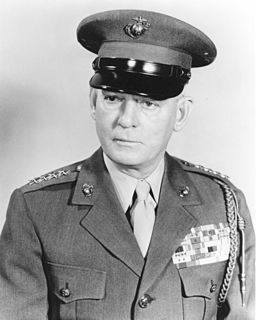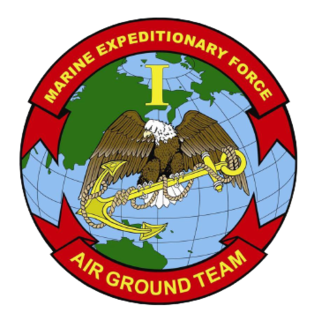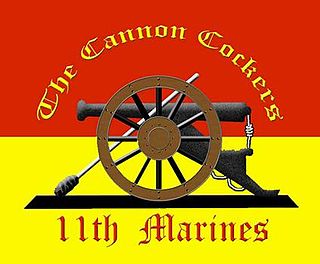
A regiment is a military unit. Its role and size varies markedly, depending on the country, service and/or a specialisation.

Corps is a term used for several different kinds of organization. A military innovation by Napoleon, the formation was first named as such in 1805. The size of a corps varies greatly, but from two to five divisions and anywhere from 40,000 to 80,000 are the numbers stated by the US Department of Defense.

The American Expeditionary Forces was a formation of the United States Army on the Western Front of World War I. The AEF was established on July 5, 1917, in France under the command of Gen. John J. Pershing. It fought alongside French Army, British Army, Canadian Army, and Australian Army units against the Imperial German Army. A minority of the AEF troops also fought alongside Italian Army units in that same year against the Austro-Hungarian Army. The AEF helped the French Army on the Western Front during the Aisne Offensive in the summer of 1918, and fought its major actions in the Battle of Saint-Mihiel and the Meuse-Argonne Offensive in the latter part of 1918.

Light infantry is a designation applied to certain types of foot soldiers (infantry) throughout history, typically having lighter equipment or armament or a more mobile or fluid function than other types of infantry, such as heavy infantry or line infantry. Historically, light infantry often fought as scouts, raiders, and skirmishers—soldiers who fight in a loose formation ahead of the main army to harass, delay, disrupt supply lines, and generally "soften up" an enemy before the main battle. After World War II, the term "light infantry" evolved, and now generally refers to rapid-deployment units that specifically emphasize speed and mobility over armor and firepower. Some units or battalions that historically held a skirmishing role have kept their designation "light infantry" for the sake of tradition.

The 28th Infantry Division ("Keystone") is a unit of the Army National Guard and is the oldest division-sized unit in the Department of Defense. Some of the units of the division can trace their lineage to Benjamin Franklin's battalion, The Pennsylvania Associators (1747–1777). The division was officially established in 1879 and was later redesignated as the 28th Division in 1917, after the entry of America into the First World War. It is today part of the Pennsylvania Army National Guard, Maryland Army National Guard, Ohio Army National Guard, and New Jersey Army National Guard.

Lemuel Cornick Shepherd Jr. was a four-star general of the United States Marine Corps. A veteran of World War I, World War II, and the Korean War, he was the 20th Commandant of the Marine Corps. As Commandant, he secured a place on the Joint Chiefs of Staff, gaining parity for the Marine Corps with the other military services.

The I Marine Expeditionary Force is a Marine Air Ground Task Force (MAGTF) of the United States Marine Corps primarily composed of the 1st Marine Division, 3rd Marine Aircraft Wing, and 1st Marine Logistics Group. It is based at Marine Corps Base Camp Pendleton.

Marines, or naval infantry, are typically a military force trained to operate in littoral zones in support of naval operations. Historically, tasks undertaken by marines have included helping maintain discipline and order aboard the ship, the boarding of vessels during combat or capture of prize ships, and providing manpower for raiding ashore in support of the naval objectives. In most countries, the marines are an integral part of that state's navy.

3rd Battalion 6th Marines is an infantry battalion in the United States Marine Corps based out of Camp Lejeune, North Carolina. Also known as "Teufelhunden", it consists of approximately 1000 Marines and Sailors. They fall under the 6th Marine Regiment and the 2nd Marine Division.

The 2nd Marine Regiment is an infantry regiment of the United States Marine Corps. They are based at Marine Corps Base Camp Lejeune, North Carolina and fall under the command of the 2nd Marine Division and the II Marine Expeditionary Force.

The 11th Marine Regiment is an artillery regiment of the United States Marine Corps based at Marine Corps Base Camp Pendleton, California. Known as the "Cannon Cockers", the regiment falls under the command of the 1st Marine Division and the I Marine Expeditionary Force. Its primary weapon system is the M777A2 howitzer with a maximum effective range of 30 km, however the 5th Battalion has converted to fire the HIMARS weapon system.
Marine Air-Ground Task Force is a term used by the United States Marine Corps to describe the principal organization for all missions across the range of military operations. MAGTFs are a balanced air-ground, combined arms task organization of Marine Corps forces under a single commander that is structured to accomplish a specific mission. The MAGTF was formalized by the publishing of Marine Corps Order 3120.3 in December 1963 "The Marine Corps in the National Defense, MCDP 1-0". It stated:

5th Battalion 10th Marines (5/10) was a US artillery battalion comprising three firing batteries and a headquarters battery. The battalion was stationed at Marine Corps Base Camp Lejeune, North Carolina, USA and its primary weapon system was the M777A2 howitzer, with a maximum effective range of 30 km. They fell under the command of the 10th Marine Regiment and the 2nd Marine Division. The battalion was known by its nickname of, "The Five and Dime."

The 1st Battalion, 6th Marines (1/6) is an infantry battalion in the United States Marine Corps based in Camp Lejeune, North Carolina. It consists of approximately 1,100 marines and sailors. They fall under the command of the 6th Marine Regiment, the 2nd Marine Division of the II Marine Expeditionary Force.

The 6th Marine Regiment is an infantry regiment of the United States Marine Corps based at Marine Corps Base Camp Lejeune, North Carolina. The regiment falls under the command of the 2nd Marine Division of the II Marine Expeditionary Force. Its combat history dates back to World War I when they were part of the American Expeditionary Force. They fought in the Pacific Theater in World War II, most notably at the battles of Guadalcanal, Tarawa, Saipan, Tinian and Okinawa. More recently, the regiment has seen combat during the Gulf War and in support of Operation Iraqi Freedom.
A regimental combat team (RCT) is a provisional major infantry unit which has seen use by branches of the United States Armed Forces. It is formed by augmenting a regular infantry regiment with smaller combat, combat support and combat service support units.

Below is an estimated list of the major units deployed within the Multi-National Force – Iraq and other United States military units that were operating in Iraq under the U.S. Central Command (USCENTCOM) in 2009, during the Iraq War.

The Philippine Army (PA) is the main, oldest and largest branch of the Armed Forces of the Philippines (AFP), responsible for ground warfare and currently has an estimated strength of over 100,000 soldiers, backed by 120,000 ready reserves.The service branch was established on December 21, 1935 as the Philippine Commonwealth Army. The Philippine Army has engaged in many conflicts including the ongoing Communist rebellion in the Philippines and the Moro conflict, and other conflicts worldwide.

This is the order of battle for invasion of Iraq during the Iraq War between coalition forces and Iraqi regular forces supported by Fedayeen Saddam irregulars and others between March 19 and May 1, 2003.
The 4th Marine Expeditionary Brigade was a brigade-sized unit of the United States Marine Corps that was designed specifically to be an anti-terrorism unit. The mission of this unit was to be a quickly deployable unit to wherever needed in the world so they could fight terrorism and deter, detect and defend from terrorist groups both domestically and internationally. The unit became operational on 29 October 2001, and was deactivated in February 2006.
















